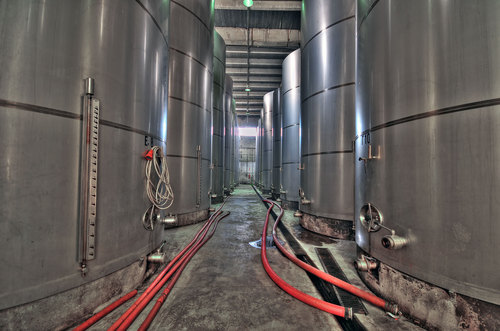Vinification of red wines
The grapes are picked carefully in containers of 20 kg capacity; they are conveyed to the winery and placed in receptacles where they are weighed and forwarded for stemming and crushing. This is where stems are separated from grape-berries, the skins of which are broken to free the juice. The must, as it is called, is forwarded to the vinification tanks where alcoholic fermentation takes place. Temperature levels are controlled, reaching 30°C the highest, thus allowing the infusion of colourings and other substances which differentiate the flavour, tannins and aromas of red wines.
During fermentation carbon dioxide (CO2) is released, which causes the leftover grape skins to float on top of the liquid thus forming a layer on the surface known as "cap". Underneath this layer, there is a rise in temperature and oxygen is decreasing. To avoid this undesirable effect, the cap must be broken up and stirred back into the wine to give it a lot of contact. Through the above technique, infusion is enhanced and temperature is homogenized. After a period of a few days, infusion has reached its maximum potential. Then is the time to separate grape juice from grape skins. The grape juice is led in stainless units, where fermentation is completed, whereas the grape skins are led to the press so that the rest of the juice can be gathered.
For red wines, after alcoholic fermentation there is malolactic fermentation in tanks, which is the conversion of malic acid to lactic acid. As a result, acidity owing to malic acid is reduced by 50%. This improves the wine's aggressive character. Then is the time for the wine to be channelled in casks for maturation and ageing.
Vinification of rose wines
Blending white with red wines in order to produce rose is strictly forbidden. The most usual method for producing rose wines is that of red vinification, with the difference that the grape juice is separated from the grape skins within 18-24 hours. Then fermentation is completed in the tanks, while temperature is kept at relatively low levels (18°C) aiming to encourage a rich aromatic character. Rose wines are noted for their freshness, softness and grapy nose and therefore should be immediately consumed and will not age.
Vinification of white wines
The grapes are picked carefully in containers of 20 kg capacity; they are conveyed to the winery and placed in receptacles where they are weighed and forwarded for stemming and crushing. This is where stems are separated from grape-berries, the skins of which are broken to free the juice. The must is promptly forwarded to the press so that the juice only can be collected. After filtering the juice it is channelled to the tanks where alcoholic fermentation is taking place. The temperature should not exceed 18°C. Fermentation is slow, at relatively low temperature, encouraging fine delicate aromas. Once fermentation has been completed, the wine is forwarded to the storage tanks. White wines are not usually subjected to malolactic fermentation as malic acid is responsible for their freshness, which is intended for this wine. Some white ones though, can be aged in casks.
Vinification of Blanc de Noir wines
Through this method, white wine is made from red grapes. Preferable varieties used are those noted for their slow release of red pigments such as Xinomavro. Vinification is the same as that for white wines. This time though, the grapes are squeezed gently to avoid extraction of red pigments from the skins.







